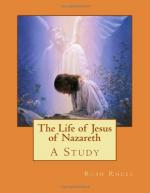87. On the location of Gethsemane and Golgotha see AndLOL 499f., 575-588; and HastBD II. 164, 226f.
88. On the progress of Jesus’ trial by the Jewish authorities, see AndLOL 505-516; GilbertLJ 359-363. The legality of the trial has been carefully discussed by A. T. Innes, The Trial of Jesus Christ.
89. On the form and sequence of Peter’s denials, see Westcott, Comm. on John, 263-266; AndLOL 516-521.
90. The Words from the Cross. Matthew (xxvii. 46) and Mark (xv. 34) report one; Luke (xxiii. 34?, 43, 46) adds three, omitting the one found in Matthew and Mark; John adds three more (xix. 26f., 28, 30). Luke xxiii. 34 is bracketed by Westcott and Hort because omitted by a very important group of MSS. ([Hebrew: aleph]^aBD*) and some early versions. The saying is almost certainly authentic, though it may have been added to Luke by some early copyist. See Westcott and Hort, N.T. in Greek, II. Appendix, 68; and Plummer, Comm. on Luke, 544f.
IX
The Resurrection and Ascension
91. Read SandayHastBD II. 638-643; see KeimJK VI. 274-383, for a still valid criticism of the position of RevilleJN II. 428-478; see also WeissLX III. 382-409; BeysLJ I. 433-481, II. 474-493; BovonNTTh I. 350-375; GilbertLJ 385-405; Loofs, Die Auferstehungsberichte und ihr Wert; EdersLJM II. 621-652; AndLOL 589-639.
92. The last twelve verses of Mark (xvi. 9-20) are omitted by the oldest MSS ([Hebrew: aleph]B) and by the recently discovered Sinaitic Syriac, as well as by other versions and fathers. An Armenian MS. has been found ascribing the section to one Ariston, or Aristion, a second century elder, and this explanation of the origin of the verses is widely accepted. The gospel cannot have ended with the words “for they were afraid,” but no satisfactory explanation of the condition of its text has been found. For a recent hypothesis see Rohrbach, Der Schluss des Markusevangeliums; on Aristion as the author, see Conybeare in Expos. IV. viii. (1893) 241, IV. x. 219, V. ii. 401; see also SandayHastBD II. 638f., Bruce, Expos. Gk. Test. I. 454f. For discussion of textual evidence see Westcott and Hort, NT in Greek, II. Appendix, 28-51, and Burgon, The last twelve verses of St. Mark (a passionate defence).
Luke xxiv. 51 is omitted by [Hebrew: aleph]*D and several old Latin MSS. See Plummer and Bruce on the passage.
93. “After three days.” This formula, which appears often in Mark, is altered in parallels in Matthew and Luke to “on the third day” (see Concordance). Jesus died on Friday, lay in the tomb over Saturday, and rose very early Sunday morning. Thus he spent a part of Friday, and a part of Sunday, and all of Saturday in the grave. According to Jewish reckoning this was counted three days.




